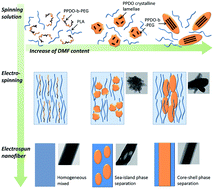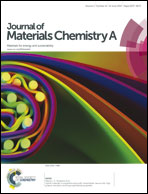Phase separation in electrospun nanofibers controlled by crystallization induced self-assembly†
Abstract
Nanofibers from poly(lactic acid) (PLA) homopolymer and poly(p-dioxanone)-b-poly(ethylene glycol) multi-block copolymer (PPDO-b-PEG) with different phase separation morphologies depending on the crystallization induced self-assembly of PPDO-b-PEG are prepared by single spinneret electrospinning. Mixing solvents of chloroform–dimethyl formamide (CHCl3–DMF) with different compositions are used for controlling the crystallization of the PPDO block and therefore the phase separation in the obtained nanofibers. The crystallization of the PPDO block has a very important influence on the morphology of the PPDO-b-PEG nanoparticles in the spinning solution. In spinning solutions with low DMF content, nanoparticles with irregular shapes and non-compact inner structures are formed because the degree of crystallization of the PPDO block is relatively low, and a discontinuous sea-island phase separation is formed in the obtained electrospun nanofibers. Meanwhile, in spinning solutions with high DMF content, the copolymer can form flake-like nanoparticles with a relatively high degree of crystallization. The flake-like shape favors compact aggregation of the PPDO phase during formation of the nanofibers, and a continuous core–shell phase separation of the nanofibers is obtained.


 Please wait while we load your content...
Please wait while we load your content...